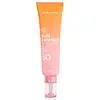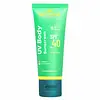What's inside
What's inside
 Key Ingredients
Key Ingredients

 Benefits
Benefits

 Concerns
Concerns

 Ingredients Side-by-side
Ingredients Side-by-side

Water
Skin ConditioningButylene Glycol
HumectantButyl Methoxydibenzoylmethane
UV AbsorberEthylhexyl Methoxycinnamate
UV AbsorberGlycerin
HumectantPhenylbenzimidazole Sulfonic Acid
UV AbsorberOctocrylene
UV AbsorberPolyacrylate Crosspolymer-11
Emulsion StabilisingBetaine
HumectantCentella Asiatica Extract
CleansingTriethanolamine
BufferingSilica
AbrasivePhenoxyethanol
PreservativeCamellia Sinensis Leaf Extract
AntimicrobialLecithin
EmollientChlorphenesin
AntimicrobialTriethylene Glycol
MaskingMethicone
EmollientWater, Butylene Glycol, Butyl Methoxydibenzoylmethane, Ethylhexyl Methoxycinnamate, Glycerin, Phenylbenzimidazole Sulfonic Acid, Octocrylene, Polyacrylate Crosspolymer-11, Betaine, Centella Asiatica Extract, Triethanolamine, Silica, Phenoxyethanol, Camellia Sinensis Leaf Extract, Lecithin, Chlorphenesin, Triethylene Glycol, Methicone
Water
Skin ConditioningEthylhexyl Methoxycinnamate
UV AbsorberButyl Methoxydibenzoylmethane
UV AbsorberButylene Glycol
HumectantOctocrylene
UV AbsorberPolymethyl Methacrylate
Phenoxyethanol
PreservativeCitric Acid
BufferingPolyacrylic Acid
Emulsion StabilisingTriethanolamine
BufferingParfum
MaskingDisodium EDTA
Ethylhexylglycerin
Skin ConditioningLecithin
EmollientGlycerin
HumectantHelianthus Annuus Seed Oil
EmollientPropylene Glycol
HumectantEuterpe Oleracea Fruit Extract
Coffea Robusta Seed Extract
Skin ConditioningEthyl Ferulate
AntioxidantRosmarinus Officinalis Leaf Extract
AntimicrobialTocopherol
AntioxidantPotassium Sorbate
PreservativeSodium Benzoate
MaskingTrisodium EDTA
Water, Ethylhexyl Methoxycinnamate, Butyl Methoxydibenzoylmethane, Butylene Glycol, Octocrylene, Polymethyl Methacrylate, Phenoxyethanol, Citric Acid, Polyacrylic Acid, Triethanolamine, Parfum, Disodium EDTA, Ethylhexylglycerin, Lecithin, Glycerin, Helianthus Annuus Seed Oil, Propylene Glycol, Euterpe Oleracea Fruit Extract, Coffea Robusta Seed Extract, Ethyl Ferulate, Rosmarinus Officinalis Leaf Extract, Tocopherol, Potassium Sorbate, Sodium Benzoate, Trisodium EDTA
 Reviews
Reviews

Ingredients Explained
These ingredients are found in both products.
Ingredients higher up in an ingredient list are typically present in a larger amount.
Also known as Avobenzone, this ingredient is a chemical sunscreen filter that provides protection in the UV-A range.
Avobenzone is globally approved and is the most commonly used UV-A filter in the world.
Studies have found that avobenzone becomes ineffective when exposed to UV light (it is not photostable; meaning that it breaks down in sunlight). Because of this, formulations that include avobenzone will usually contain stabilizers such as octocrylene.
However, some modern formulations (looking at you, EU!) are able to stabilize avobenzone by coating the molecules.
Avobenzone does not protect against the UV-B range, so it's important to check that the sunscreen you're using contains other UV filters that do!
The highest concentration of avobenzone permitted is 3% in the US, and 5% in the EU.
Learn more about Butyl MethoxydibenzoylmethaneButylene Glycol (or BG) is used within cosmetic products for a few different reasons:
Overall, Butylene Glycol is a safe and well-rounded ingredient that works well with other ingredients.
Though this ingredient works well with most skin types, some people with sensitive skin may experience a reaction such as allergic rashes, closed comedones, or itchiness.
Learn more about Butylene GlycolEthylhexyl Methoxycinnamate is an organic compound that provides UVB protection. It often goes by the more common name of octinoxate. It is created from methoxycinnamic acid and 2-ethylhexanol.
Ethylhexyl Methoxycinnamate absorbs UVB rays with wavelengths between 280-320 nm. UV absorbers protect your skin by using chemical reactions to convert UV rays into heat and energy.
UVB (290-320 nm) rays emit more energy than UVA rays. They are capable of damaging DNA, causing sunburns and are thought to be linked to skin cancer.
The state of Hawaii has banned sunscreens containing octinoxate due to its potential impact on coral reefs. More research is needed to bridge gaps in this research. The European Union allows higher levels of octinoxate in sunscreens than the US and Australia.
Ethylhexyl Methoxycinnamate is oil soluble. It is not stable and may lose efficacy when exposed to sunlight.
Learn more about Ethylhexyl MethoxycinnamateGlycerin is already naturally found in your skin. It helps moisturize and protect your skin.
A study from 2016 found glycerin to be more effective as a humectant than AHAs and hyaluronic acid.
As a humectant, it helps the skin stay hydrated by pulling moisture to your skin. The low molecular weight of glycerin allows it to pull moisture into the deeper layers of your skin.
Hydrated skin improves your skin barrier; Your skin barrier helps protect against irritants and bacteria.
Glycerin has also been found to have antimicrobial and antiviral properties. Due to these properties, glycerin is often used in wound and burn treatments.
In cosmetics, glycerin is usually derived from plants such as soybean or palm. However, it can also be sourced from animals, such as tallow or animal fat.
This ingredient is organic, colorless, odorless, and non-toxic.
Glycerin is the name for this ingredient in American English. British English uses Glycerol/Glycerine.
Learn more about GlycerinLecithin is a term for a group of substances found in the cell membranes of plants, animals, and humans. They are made up of mixture of phospholipids.
This ingredient has emollient and emulsifying properties.
As an emollient, lecithen helps soften the skin and creates a barrier to keep moisture in.
As an emulsifier, it also helps prevent water and oil ingredients from separating. Lecithin can also help ingredients be better absorbed by the skin.
This is because the phospholipids in lecithin produce liposomes. Liposomes help other ingredients get through the skin barrier.
Depending on the source of this ingredient, lecithin may not be fungal acne safe. This is because some sources of lecithin come from soybean oil, which may feed the malassezia yeast that feeds fungal acne.
We recommend reaching out to the brand you are purchasing from to inquire about the source of their lecithin.
Some other names for this ingredient include soy lecithin and deoiled soy lecithin.
Learn more about LecithinOctocrylene protects skin from sun damage. It absorbs UV-B with peak absorption of 304 nm. It is a common sunscreen ingredient and often paired with avobenzone, a UVA filter. This is because octocrylene stabilizes other sunscreen ingredients by protecting them from degradation when exposed to sunlight. Octocrylene is a photostable ingredient and loses about 10% of SPF in 95 minutes.
Octocrylene also acts as an emollient, meaning it helps skin retain moisture and softens skin. It is oil-soluble and hydrophobic, enhancing water-resistant properties in a product.
Those who are using ketoprofen, a topical anti-inflammatory drug, may experience an allergic reaction when using octocrylene. It is best to speak with a healthcare professional about using sunscreens with octocrylene.
The EU allows a maximum of these concentrations:
Learn more about OctocrylenePhenoxyethanol is a preservative that has germicide, antimicrobial, and aromatic properties. Studies show that phenoxyethanol can prevent microbial growth. By itself, it has a scent that is similar to that of a rose.
It's often used in formulations along with Caprylyl Glycol to preserve the shelf life of products.
Triethanolamine is an emulsifier and pH adjuster. It is created using ethylene oxide and ammonia. This gives Triethanolamine a nitrogen core and a similar scent to ammonia.
As an emulsifier, it prevents ingredients from separating and enhances texture by adding volume to a product.
PH adjusters are common in cosmetic products. The pH of a product can affect the effectiveness of other ingredients. A product with a high pH may also irritate the skin.
Learn more about TriethanolamineWater. It's the most common cosmetic ingredient of all. You'll usually see it at the top of ingredient lists, meaning that it makes up the largest part of the product.
So why is it so popular? Water most often acts as a solvent - this means that it helps dissolve other ingredients into the formulation.
You'll also recognize water as that liquid we all need to stay alive. If you see this, drink a glass of water. Stay hydrated!
Learn more about Water